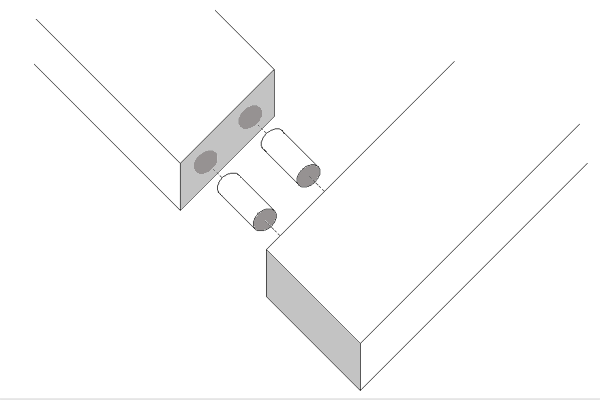I think I am unnecessarily putting in too many screws when screwing wood together after gluing. How far apart can you place screws? Maybe 3-4 inches?
Why not use clamps?
jeff
I do use clamps to hold it in place until I screw some wood screws in. Then take the clamps off and let it cure overnight.
Leaving a bunch of clamps in aren't an option because they are big speakers and I don't have lots of clamps to keep on the speaker(s) overnight.
Plus whats wrong with screws? It's standard practice (for DIYers) to use screws to hold speakers together while the glue dries.
Plus whats wrong with screws?
Nothing, as long as they don't interfere with veneering etc.
It's standard practice (for DIYers) to use screws to hold speakers together while the glue dries.
It is? I see a lot of pictures with clamps in them.😉
I realize building large boxes is a challenge.
jeff
Last edited:
If you're going to use screws, and I do/would, definitely put them in before the glue goes off.
Actually, pilot and countersink the upper panel, assemble with clamps, run pilots into the lower panel/screw block, assemble with screws alone, disassemble, apply glue, screw and wipe. A positive self-locating distributed-pressure clamping system.
How close together you put the screws depends on speaker type, size, weight, intended useage - ie use your skill and judgement.
If you don't want the screws to stay in there, you can always take them out after the glue's set, drill out and dowel. Though your radar signature will probably still be bad on account of the metal in the speaker.....
Actually, pilot and countersink the upper panel, assemble with clamps, run pilots into the lower panel/screw block, assemble with screws alone, disassemble, apply glue, screw and wipe. A positive self-locating distributed-pressure clamping system.
How close together you put the screws depends on speaker type, size, weight, intended useage - ie use your skill and judgement.
If you don't want the screws to stay in there, you can always take them out after the glue's set, drill out and dowel. Though your radar signature will probably still be bad on account of the metal in the speaker.....
If you don't want the screws to stay in there, you can always take them out after the glue's set, drill out and dowel. Though your radar signature will probably still be bad on account of the metal in the speaker.....
The point of joining cabinetry with dowels is not only strength but that there are no holes on the finished surfaces.
The point of joining cabinetry with dowels is not only strength but that there are no holes on the finished surfaces.
Err, yes, I didn't really think he needed a stealth cabinet. 😀
Not sure why this isn't showing, but had email notification saying;
Don't break it off, saw it off close in with a fine saw. Then sand.After hammering in the dowel and breaking it, are you able to sand off the rest to make it smooth?
You don't need to leave clamps on overnight. ALso, it maybe standard practice for pro audio gear that gets thrown around and ultimately covered in duratex or similar but it's really a substandard practice.
You can always clamp one box at a time. You won't like this response, but there it is. Any fastener will be visible, including dowels.
You can always clamp one box at a time. You won't like this response, but there it is. Any fastener will be visible, including dowels.
I do use clamps to hold it in place until I screw some wood screws in. Then take the clamps off and let it cure overnight.
Leaving a bunch of clamps in aren't an option because they are big speakers and I don't have lots of clamps to keep on the speaker(s) overnight.
Plus whats wrong with screws? It's standard practice (for DIYers) to use screws to hold speakers together while the glue dries.
Any fastener will be visible, including dowels.
Properly used, dowels are not visible. Illustration from wikipedia:

Add a Brad nailer to that mix and you can get by with very few clamps.Clamp and glue.
If you use a Brad nailer you will increase the speed more than you can imagine.I do use clamps to hold it in place until I screw some wood screws in.
Once you have it nailed, you take off the clamps and move onto the next panel. No stoppages, no waiting.Then take the clamps off and let it cure overnight.
They take a lot longer and are really only make sense if your tools are limited.Plus whats wrong with screws?
Rope with a bungee cord can be very good, as can those racheted tie-down straps, tape etc.Often forgotten is use of rope. Cheap clamp.
In some cases clamps aren't practical. Like when you are doing an octagon for example.
Whatever works and doesn't take too long. 🙂
I do use clamps to hold it in place until I screw some wood screws in. Then take the clamps off and let it cure overnight.
Leaving a bunch of clamps in aren't an option because they are big speakers and I don't have lots of clamps to keep on the speaker(s) overnight.
Look at the glue bottle for how long clamps need to be in place, it might not be that long. I used regular wood glue on my kit and this needed to be clamped down for no more than an hour.
It might sound rediculously short, but it worked fine for me. Just don't stress the joints until the glue has fully cured.
Last edited:
- Status
- Not open for further replies.
- Home
- Design & Build
- Construction Tips
- How far apart do you need to space screws after gluing?